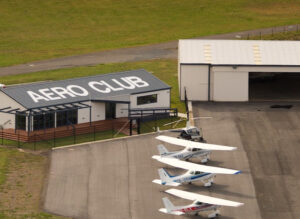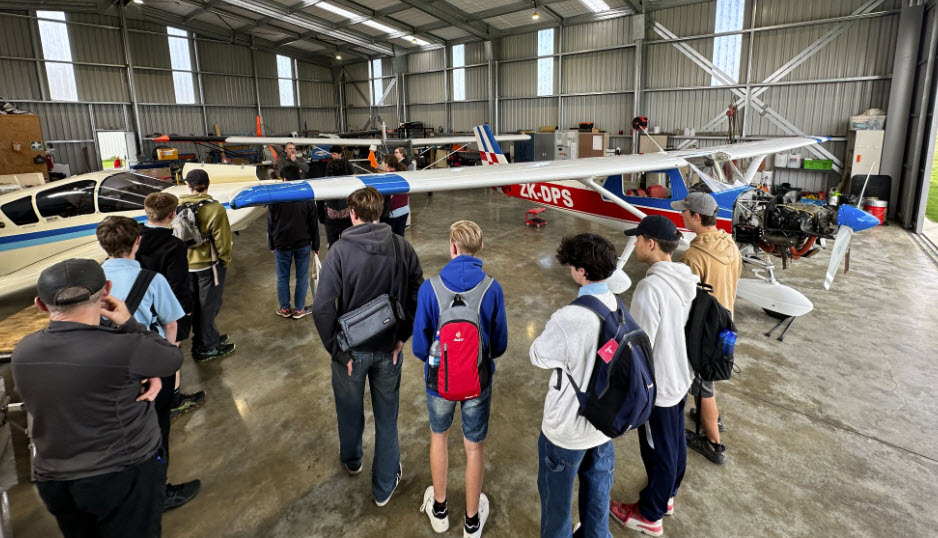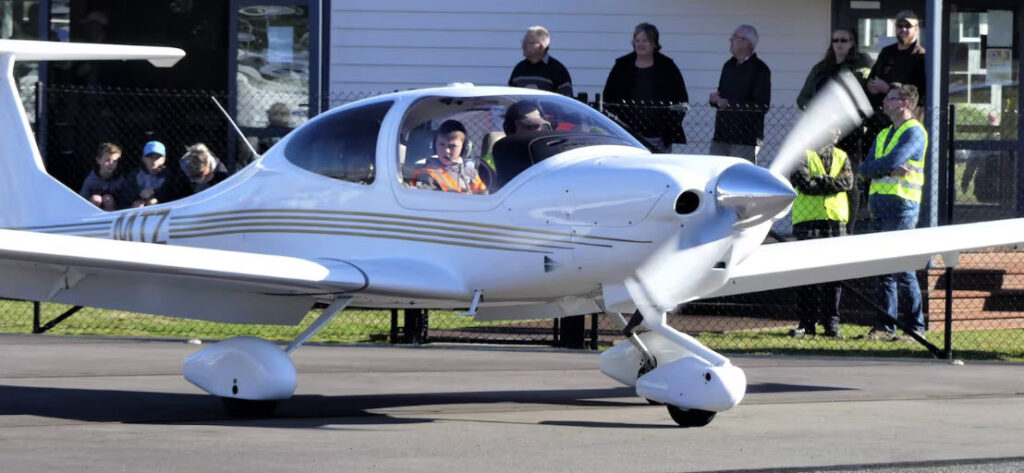
Kāpiti Aero Club in Your Community
Your local flight organisation.
 Kāpiti Aero Club has a long history on the Kāpiti Coast, with origins dating back to 1983.
Kāpiti Aero Club has a long history on the Kāpiti Coast, with origins dating back to 1983.
Staffed by a team of experienced instructors and volunteers, the club is the preeminent flight training organisation in the Wellington region. Over the years we’ve trained thousands of pilots, with many going on to have successful careers with airlines such as Air NZ and Sounds Air as well as live-saving air medical operations.
The next time you catch a flight around New Zealand or travel overseas, there’s a good chance the pilot learned to fly at Kāpiti Aero Club!
Page contents:
- Community Involvement
- Noise Management Plan
- Low Flying
- Fly Neighbourly Programme
- Aviation Fuel
- Kāpiti Aero Club in the News
Community Involvement
Young Eagles Programme
Kāpiti Aero Club is committed to supporting youth in aviation.
That’s why we run the non-profit Young Eagles Programme, backed by Flying NZ.
This long-running programme is designed to introduce young adults to aviation and provide them with an opportunity to experience and gain knowledge of the different sectors within the aviation industry. Supported by our volunteer members, the Young Eagles experience a wide range of aviation activities such as free local and cross-country flights in our club aircraft, visits to Wellington Air Traffic Control Tower, the LifeFlight base, Ohakea air force base, engineering workshops and more.
Find out more about the Kāpiti Aero Club Young Eagles programme here.
Police Blue Light events
The NZ Police Blue Light Take a Kid Flying programme has been running for nearly 10 years and is a collaboration between the Blue Light Charity, Aircrafts Owners and Pilots Association (AOPA) and the police.
Each year around 30 young people are invited to events around the country, with the Kāpiti event being held at Kāpiti Coast Airport, hosted by the Kāpiti Districts Aero Club.
Community group visits
The Kāpiti Aero Club welcomes visits from other community groups, such as Scouting NZ. Please get in touch with us if you’d like to organise a private visit to Kāpiti Airport or Kāpiti Aero Club. We’d love to show you around!
Civil emergencies
From time-to-time aero club members have provided assistance to those affected by civil defence emergencies, the most recent occasion being Cyclone Gabrielle in Hawkes Bay (2023). Our aircraft may be small but they can ferry essential items to those in need.
Open days
Our open days are a great opportunity to visit the aero club, check out our aircraft fleet or even go on a trial flight. Please follow our Facebook page to stay up-to-date about upcoming aero club events.
Noise management plan
Kāpiti Aero Club is committed to minimising noise impact in our local community. We work closely with the airport company and Kāpiti Coast District Council to ensure our operations follow all applicable rules in the district plan. As such, we’re a member of the Community Liaison Group (CLG). The CLG works to improve communication between residents around the Kāpiti Coast Airport, airport users and Council, helps people understand and comply with airport noise rules, and administers the Kāpiti Coast Airport Noise Management Plan.
Low Flying
The minimum acceptable heights for flying are laid out in a group of rules called ‘Part 91’ (Rule 91.311 Minimum heights for VFR flights).
Briefly stated, the minimum height an aircraft is allowed to fly over a city, town, or settlement, is 1000 feet above the highest obstacle, except when taking off or landing. Generally, 1000 ft is the height at which aircraft are flown within the circuit of an aerodrome.
The minimum height over any other area is 500 feet. There are exceptions, such as aircraft flying within a designated low flying training area, during a flight training exercise or examination providing certain conditions are met, in agricultural aircraft operations, during emergencies, and when the genuine purpose of the flight requires the aircraft to be flown at a lower height – such as during a police operation.
A note about Flight tracking apps:
Flight tracking apps such as FlightRadar24 and FlightAware are fantastic tools for following flights, we know – we use them too!
It is, however, important to understand how these tools often report low altitudes incorrectly. In fact the only time the altitude reported is correct is when the air pressure is exactly 1013 hPa. For example, a flight tracking app may show the altitude of an aircraft being reported as 300ft, whereas the actual altitude flown is 500ft.
Why is that?
Flight tracking apps calculate altitude based on standard atmospheric pressure (1013 hPA) and not the actual barometric pressure at the time (say, 1023 hPA). Each hPA roughly corresponds to 30ft in altitude. So when the local pressure is higher than the standard atmospheric pressure of 1013, flight tracking apps will under-read altitudes – this can amount to hundreds of feet!
These errors are insignificant when tracking airliners at 30,000ft. The problem occurs when these flight tracking apps are used to try to determine if general aviation aircraft are flying below the prescribed minimum safe altitudes. Independently verified altitude data is only available through Airways NZ and it isn’t publicly available.
Fly Neighbourly Programme
Beyond what’s legally required, Section 2.6 of our Flight Orders Member Rules document outlines further steps to minimise the impact of our flight operations on our local community:
All pilots operating Kāpiti Aero Club aircraft must be familiar with and adhere to the Kāpiti Coast Airport Airport Noise Management Plan at all times, particularly sections 3.3.2 General Noise Mitigation Procedures and 3.3.3 Specific Operational Considerations.
Aircraft should be flown as to minimise the impact of noise to built up areas. This includes flying at higher than the minimum altitudes whenever possible and selecting tracks that take aircraft away from homes as soon as practicable.
Night circuits in Kāpiti Aero Club aircraft are prohibited during NZDT (New Zealand Daylight Time) unless prior approval has been received from the Chief Flying Instructor. This approval will be given only to comply with night currency requirements or training that cannot be accommodated at a different time or location. During New Zealand Standard Time, repetitive circuit training should be completed by 2100 local time and no more than 4 aircraft should be performing repetitive circuits at any one time.
Engine Failure After Take-off (EFATO) practice should be limited to 3 EFATOs per aircraft per flight while in the circuit. The aircraft should initiate a go around at 600 AGL. EFATO practice is limited to dual flights only.
Low Flying practice in the vicinity of Te Horo should be spread around to avoid repetitive overflight of the same area. Due care should be taken to avoid the area when there are congregations of people, particularly around the Katihiku Marae.
Operations at Otaki Airfield should be limited to a maximum of 3 standard overhead joins or forced landing practice per aircraft. A maximum of 4 aircraft per day can utilise Otaki Airfield for practice per day.
Other operational restrictions may be instituted from time to time by the duty instructor to mitigate the impact of our operations on the general public.
Aviation Fuel
Most single engine piston aircraft used in general aviation here in New Zealand and around the world use Avgas 100LL. Tetraethyl lead (TEL) is an additive to Avgas to ensure aviation engines can run safely. The amount of TEL it is restricted to less than <0.14% weight/volume, equivalent to <0.85g lead per litre of fuel. The Environmental Protection Agency has approved Avgas 100LL under the Hazardous Substances and New Organisms Act 1996 (HSNO Act).
No unleaded aviation fuel alternative to 100LL Avgas is currently approved for use in New Zealand. Kāpiti Aero Club is committed to switching to unleaded Avgas fuel alternatives such as G100UL as soon as they are approved for use and distributed in the country.
In the meantime, as a good neighbour, the club has undertaken soil sampling to understand the current impact of our operations on the community. Soil samples have been tested in a number of locations in and around the airport including high movement areas. The results from the laboratory testing showed any traces of lead to be well under acceptable levels and in fact lower than what can naturally occur in the environment.
New Zealand’s first electric aircraft visits Kāpiti
21 Jun, 2021





